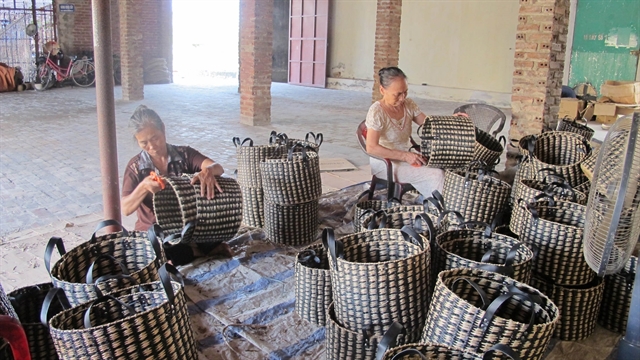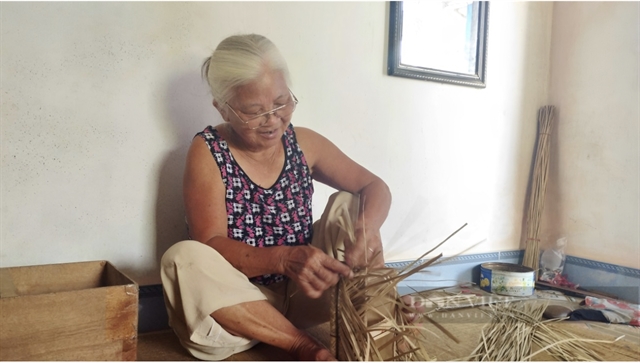 Life & Style
Life & Style

 |
| Nguyễn Thị Nhâm, 80, has been cói weaving for 70 years. She is one of elderly in Tây An Commune of Thái Bình Province preserving the traditional craft. — Photo danviet.vn |
THÁI BÌNH — Many elderly people in Thái Bình Province still maintain the traditional craft of cói weaving which they have done for decades.
With skillful hands and a deep love for the craft, they keep the tradition alive and pass it down to future generations. Products made from cói are now exported to many countries worldwide.
Weaving at eighty
The people of Tiền Hải District are known for their dexterity and have passed down the cói weaving craft through generations. This has led to the women in the area being recognised for their meticulousness, agility and deep passion for the craft.
In the past, when life was more challenging, residents grew and harvested cói to produce cói bags and hats for local sale to supplement their income. As society developed, the village’s products began to be introduced and exported further afield.
Nguyễn Thị Nhâm of Tây An Commune of Tiền Hải District has been involved in the traditional craft since she was ten and is now eighty-five years old.
Nhâm told danviet.vn: “The cói weaving craft has been in this commune for generations. From the time I was born, I was taught by my grandparents and parents. I was told that the place where I was born is the root of the cói craft, which later spread to other areas like Hưng Hà District of Thái Bình Province and Nghĩa Hưng District of neighbouring Nam Định Province.”
Despite her failing eyesight, Nhâm's hands remain quick and skillful in weaving cói.
“When we were young, the only craft in the commune was cói weaving. Many people relied on this craft to support their families. Children were able to study properly and succeed, so I cherish it greatly,” Nhâm said.
“Even at my age, many people still weave cói daily to earn extra income and to set an example for the younger generation to preserve this traditional craft,” she said.
The weaving craft requires patience as it involves many meticulous steps, from selecting sedge, washing, soaking it, drying and then pressing it.
The selected grass must be of the right maturity – not too old or too young – for easy pressing.
Soaking grass requires skill and experience, especially when the plants are soaked or swollen, they need to be handled correctly. After drying, the grass is pressed to create materials for weaving.
Next, the grass is put through a machine to be threshed and dyed to achieve attractive colours before being pressed for softness.
It is crucial to keep the colours consistent to produce beautiful products.
Once the grass strands meet standards, the artisans begin weaving them into finished products. After weaving, the products are dried and then cut, trimmed, tagged and packaged for sale.
“Once pressed, the grass must be sorted by size and colour to ensure a harmonious weave. Products from the grass are very diverse from baskets, hats, bags to mats. We can weave anything,” Nhâm said.
 |
| The baskets made of cói have gone from having no name or brand, just hanging around in rural markets, to now being present in many provinces and cities in the country and being shipped abroad. — Photo danviet.vn |
Exporting cói products
According to the artisan, products from Tây An Commune have evolved from being nameless and brandless, only sold locally, to now being sold in many other provinces and even exported.
The significant contributor to this development is Phạm Thị Ngắn, who founded a company and marketed the products to various companies.
Ngắn quickly grasped market demands and foreign tastes, gradually helping Tây An's cói products reach the world.
Ngắn says proudly: “Each month, our company exports many products like handbags and baskets to countries such as the US, Japan and Thailand, creating job opportunities for thousands of workers.
“This is a source of pride and motivation for Tây An residents to continue preserving and developing the cói weaving craft, contributing to the prosperity of the homeland."
Ngắn said that she has always dreamed of creating more jobs for rural workers, especially women.
Thanks to the presence of cói product companies, many women, especially the elderly, in Tây An Commune have found part-time jobs to increase their income.
Trần Thị Diệp, 80, said: “I was taught to weave cói by my mother since I was little. Later, after getting married, I continued with my mother-in-law.
“I receive cói from the company to weave and earn a wage.”
For large items, Diệp can weave two to three pieces per day, while smaller items can be seven pieces.
For small boxes, the wage is VNĐ10,000 (4 US cent) per piece, while larger products can earn up to VNĐ100,000 ($4) per piece.
Nguyễn Thị Thơm, 45, said: “Even though I have a stable job, I still receive cói from Ngắn's company to weave in the evenings.
“Each month, I weave 50-60 different-sized products, earning a decent income.”
Today, cói products are continually being improved, attracting more customers and increasing both quality and profitability.
Cói products are now decorated with patterns and designs before hitting the market, rather than being sold as raw products like before.
The cói weaving craft has expanded to over 20 communes in Tiền Hải District, creating jobs for over 1,500 people. From natural sedge materials, the skilled hands of craftsmen have created intricate and beautiful hats, baskets, and more.
 |
| Cói weaved products are introduced in fairs. — Photo danviet.vn |
Currently, the Tiền Hải District Elderly Association places great emphasis on organising traditional craft conferences and awarding certificates and commendations to encourage elders to continue passing on their skills.
Additionally, many businesses have launched projects encouraging locals to introduce workers to traditional cói weaving companies with attractive commissions, thereby expanding the craft network in the province.
And the authorities regularly organise exhibitions like One Commune One Product (OCOP) fairs to introduce local cói products, thus expanding the market and bringing the craft closer to the public. — VNS




